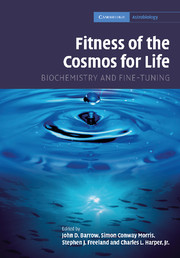Book contents
- Frontmatter
- Contents
- List of contributors
- Foreword: The improbability of life
- Preface
- Acknowledgments
- Part I The fitness of “fitness”: Henderson in context
- Part II The fitness of the cosmic environment
- Part III The fitness of the terrestrial environment
- 10 How biofriendly is the universe?
- 11 Tuning into the frequencies of life: a roar of static or a precise signal?
- 12 Life on earth: the role of proteins
- 13 Protein-based life as an emergent property of matter: the nature and biological fitness of the protein folds
- 14 Could an intelligent alien predict earth's biochemistry?
- 15 Would Venus evolve on Mars? Bioenergetic constraints, allometric trends, and the evolution of life-history invariants
- Part IV The fitness of the chemical environment
- Index
- References
10 - How biofriendly is the universe?
Published online by Cambridge University Press: 18 December 2009
- Frontmatter
- Contents
- List of contributors
- Foreword: The improbability of life
- Preface
- Acknowledgments
- Part I The fitness of “fitness”: Henderson in context
- Part II The fitness of the cosmic environment
- Part III The fitness of the terrestrial environment
- 10 How biofriendly is the universe?
- 11 Tuning into the frequencies of life: a roar of static or a precise signal?
- 12 Life on earth: the role of proteins
- 13 Protein-based life as an emergent property of matter: the nature and biological fitness of the protein folds
- 14 Could an intelligent alien predict earth's biochemistry?
- 15 Would Venus evolve on Mars? Bioenergetic constraints, allometric trends, and the evolution of life-history invariants
- Part IV The fitness of the chemical environment
- Index
- References
Summary
Introduction
We live in a biofriendly world. Were it otherwise, we wouldn't be around. The question is, therefore, how biofriendly is it? Physicists have addressed this question and have come to the conclusion that if any of the fundamental physical constants were a little smaller or a little larger than they are, the universe would be very different from what it is and unable to produce or harbor living organisms. Not everyone, however, subscribes to the concept of “fine-tuning” embodied in the so-called Anthropic Principle, some preferring instead the notion of a “multiverse,” in which our universe is only one in trillions of trillions, perhaps the only one that, by mere chance, happened to have the right combination of constants to enable it to serve as our birthplace and abode.
In contrast, biologists and other scientists interested in biology generally take the universe for granted and ask instead to what extent the manifestations of life, including humankind, fit within the existing physical and cosmic framework. Nothing could better illustrate the depth of their ignorance on this subject than the diversity of answers they have given, which cover virtually the whole array of possibilities. Many agree with the late Jacques Monod, who, in his best-seller Chance and Necessity (1971), expressed his skepticism in the oft-quoted sentence: “The Universe was not pregnant with life, nor the biosphere with man.”
- Type
- Chapter
- Information
- Fitness of the Cosmos for LifeBiochemistry and Fine-Tuning, pp. 169 - 196Publisher: Cambridge University PressPrint publication year: 2007



